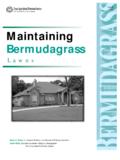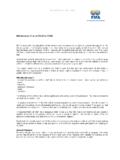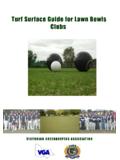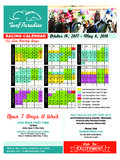Transcription of The Dirt T u rf - Red Hen Turf Farm
1 The dirt on TurfWhat You Need to Know About Synthetic turf and Natural Grass for Athletic FieldsWritten by:David Millar of Red Hen turf Farm, New Carlisle, Indiana and Aaron Loan of Blue Grass Enterprises, Cedar Rapids, IowaFor people to completely understand all the costs, use restrictions, and maintenance tasks of artificial turf , they either need to have had many years of experience maintaining natural turf , attended numerous artificial turf seminars and spoken with people who actually maintain artificial turf , or have been directly involved with all areas of managing an artificial field for over 10 years.
2 The chance that a school or park department has such a person is very slim. Aaron Loan of Blue Grass Enterprises and David Millar of Red Hen turf Farm have developed a Beginner s Guide to Artificial turf and a Fact-Finding Guide to assist schools and park departments as they consider artificial turf . The Beginner s Guide follows a logical path of learning about the important details of owning artificial turf and then follows with a worksheet you can fill in with your own costs. Upon completion, you will have a good understanding of the risks and true costs of owning an artificial dirt on TurfDavid Millar of Red Hen turf Farm, New Carlisle, Indiana, and Aaron Loan of Blue Grass Enterprises, Cedar Rapids, Iowa, are turfgrass producers who independently explored installing artificial turf as an additional division to their turfgrass production.
3 After a lengthy investigation period, both decided not to install artificial turf because they concluded that artificial turf is not an economical alternative to natural grass in most school and city have watched though, as schools and towns decided to install artificial turf without ever seeming to have considered many important facts. Artificial turf is so new to most people that they simply don t know what questions to is exactly why they wrote this booklet. The Beginner s Guide to Artificial turf is a concise What a Board member needs to know education about artificial turf .
4 The Fact-Finding Guide is a step-by-step model schools and towns can use to ask the tough questions and gather their own wrote this and why THE dirt ON turf 3A Beginner s Guide to Artificial Sports TurfThe only thing that natural grass and artificial sports turf have in common is that they are green and used for sports fields. Because they are both referred to as turf , people tend to think they are similar. Some may think artificial turf is better because it does not need to be mowed, watered or fertilized. However, there are many crucial differences between natural and artificial turf .
5 Schools and individuals should be educated about differences in maintenance, pricing, repair, injury risks and environmental concerns. How to use this information The purpose of this paper is to provide you with information that may not be provided by artificial turf salespeople, so you will be empowered to ask the right questions as you go through the process of deciding if artificial turf is right for your situation. If your school is in the process of making a decision about whether to install an artificial or natural turf field, please read through the information found in this Beginner s Guide first, and then use our Fact-Finding Guide to help with your decision of whether an artificial field makes sense for your situation.
6 Comparisons In recent years, artificial turf has emerged as an alternative to natural turf . However, we are only now beginning to understand the long-term effects of an artificial field on our athletes and environment as well as our budgets. Before you make comparisons, remember that natural grass fields offer a range of quality when it comes to construction ( , good, better or best). Be sure you are not comparing a good natural grass field that was installed 20 years ago with today s best artificial field. One should compare a newly installed natural grass field with a newly installed synthetic surface.
7 Lastly, be sure to check that the costs of the field are kept separate from other stadium improvements, such as bleachers, concession stands and lighting. A Beginner s Guide to Artificial Sports TurfThe only thing that natural grass and artificial sports turf have in common is that they are green and used for sports are many crucial differences between natural and artificial turf . Schools and individuals should be educated about differences in maintenance, pricing, repair, injury risks and environmental concerns. 4 THE dirt ON TURFT here are two parts to an artificial sports field, the base and the infilled carpet.
8 The base is comprised of a layer of coarse stone or rock that contains drain tile. The infilled carpet has fibers that are about two inches long and an infill material (usually a mix of crumb rubber and sand) is brushed into the fibers, leaving about half an inch of exposed leaves. The carpet has a life of about eight to 12 years and must be replaced for appearance and player safety. Often this replacement is necessary because the infill is too hard and the plastic fibers have broken off. Maintenance: Artificial turf fields must be vacuumed to remove all leaves and debris.
9 They must have the fibers brushed up regularly and occasionally be deep raked to loosen up the infill. Fields must also be disinfected, washed, and have loose seams repaired. Chewing gum and hard candy must be softened with a solvent and then hand pried out of the fibers. Sunflower seed shells are particularly difficult to remove. Most artificial turf companies routinely promote greatly reduced maintenance costs with their product, which can be misleading. For example, it is true that less fertilizer is used, but more labor is needed. In the Midwest, artificial turf maintenance managers report a range in savings from a little to none with artificial turf .
10 At least four specialized tools are needed for artificial turf maintenance: 1. A brush for the fibers. 2. A rake to stir the infill (to keep it from getting too compact). 3. A sweeper to pick up debris. 4. A sprayer to disinfect and spray anti-static material. (Since a football field is about two acres, a hand sprayer would take too much time, so a bigger sprayer is needed and it must be dedicated to the artificial field and cannot be used for spraying weeds.) Fields with nearby trees need more sweeping than those without trees. Repairing loose seams is a common problem that becomes more frequent as the carpet ages.





